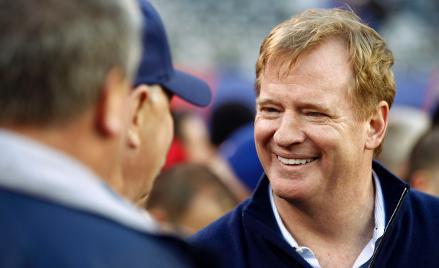Is it possible to make tackle football safe? It wasn’t safe on Sunday for Michael Vick, Alex Smith, and Jay Cutler, all three of whom left their games early after suffering concussions. And it’s not just a dangerous game for quarterbacks, of course—the NFL has now moved past 130 diagnosed concussions this season, according to the watchdogs at NFL Concussions.
But NFL commissioner Roger Goodell believes that these injuries can be the exception rather than the rule. According to Goodell, there’s a technique that can turn American blood sport into safe football. It’s called “heads-up tackling,” and he wants to teach it to the nation’s children. “You have to have the right fundamentals. You have to learn how to tackle safely and how to play the game safely,” Goodell says in a video about a “groundbreaking national youth football safety program” created by USA Football in partnership with the NFL. (USA Football, which is endowed by the NFL and the NFLPA, is the sport’s youth governing body.)
It’s not just the NFL’s PR machine that’s endorsing this safer approach to tackling. The heads up approach has been endorsed by the CDC and by a panel of sports-medicine experts that recently convened in Switzerland. Don’t believe them. So long as football players wear helmets, they’re going to bash each other with them. There’s no such thing as safe tackling, and there’s no getting your head out of the game.
What does heads up tackling look like? This video created by USA Football demonstrates the technique.
Got that? “Knuckles up, elbows down like you’re throwing double uppercuts.” As a former head-basher in NCAA football, I can say that this is a technique that I’ve seen precisely no one, ever, use on the field. The way I understand it, tacklers are somehow supposed to launch themselves chest first into their opponents, who damn well better do the same or the tackler gets annihilated. The only way this will work is if tackle football is replaced by a version of the game without bullet-head helmets, in which a player is down if you bang him in the chest.
Even if you focus on juvenile players more narrowly, it should be obvious instantly that nobody plays like this. Over the last week, there’s been a video of a star youth player named Sam Gordon going around. Gordon, a nine-year-old girl, is seen darting through tacklers with great bursts of speed. And also, at the end of the reel, there’s a section titled “taking a hit,” in which Gordon absorbs repeated shots on or near her head. None of these kids are using anything resembling a “knuckles up, elbows down” approach to tackling. They’ve all got the crowns of their helmets forward, ready to strike.
The “heads-up” technique is time-honored football BS, industry rhetoric that’s been dished out since the 1970s under the banner of “form tackling” or “proper contact.” I echo the words of Nate Jackson, who wrote the following in the roundtable two months ago:
It seems to me the height of grandiosity to assume you can trick people into believing that running into other people at high speeds can be made safe. We’ve gone over in extensive detail the reasons why it’s impossible not to hit with your head on the football field. … To ask the body, while traveling at [football] speed, to crane the neck up and back, in defiance of physics, is a fool’s errand.
Browns linebacker Scott Fujita, who I interviewed by phone earlier this year, also chortled at the suggestion that the risk of brain injury can be reduced by better coaching. “There’s increased emphasis on trying to clean up the game, you know, coaching guys up in ‘proper technique’ and all these catch phrases, and paying lip-service to everything,” Fujita says. “It’s just a brutal game, and I don’t think you can … ‘technique the game’ into becoming safer.
Tackle football has real dangers, especially for kids. In endorsing heads-up football, Goodell is trying to define down the sport’s problems. He wants us to believe that the game is not in existential crisis—that everything will be OK so long as the players follow simple rules. Those kinds of statements from Goodell and others, as well as programs that push a supposedly safe version of football, dupe naïve parents, pose undue risk for trusting juveniles, and raise the legal stakes for vulnerable coaches and hosting entities.
No one can effectively teach and instill foolishness like heads up. If the NFL is truly serious about protecting kids instead of building up the sport’s talent pool, then the league and the players’ union should start listening to the growing medical call to end tackle football for pre-adolescents. And football officials have a fellow insider to lead them: Dr. Robert Cantu, the neurologist, injury researcher, and NFL advisor who’s now recommending no child should attempt tackling until entering high school.
